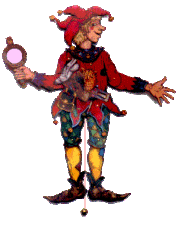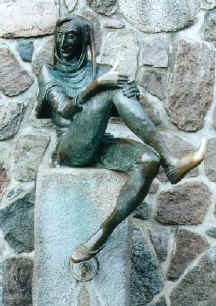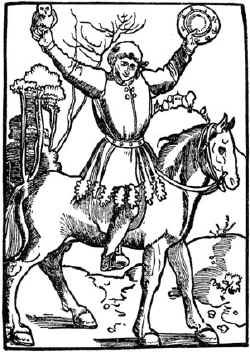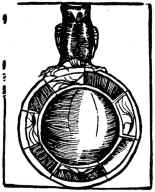from articles appearing in Prosit between September 1998 and June 1999 by John M. Gaustad and Walt Vogdes
Brittanica notes: "The jests and practical jokes, which generally depend on a pun, are broadly farcical, often brutal, sometimes obscene, often scatological; but they have a serious theme. In the figure of Eulenspiegel, the individual gets back at society; the stupid but cunning peasant demonstrates his superiority to the narrow, dishonest, condescending townsman, as well as to the clergy and nobility. ... Eulenspiegel has been the subject of musical and literary works, notably Strauss' Symphonic poem Till Eulenspiegel's lustige Streiche (Till Eulenspiegel's Merry Pranks) (1894), and Gerhart Hauptmann's epic poem Till Eulenspiegel." The earliest known complete edition of Eulenspiegel's adventures was written by an unknown author who used the pen name "N." Printed in 1515 by Johannes Grüninger, it was accompanied by woodcuts by Hans Baldung Grien, a friend and assistant to Albrecht Dürer (1471-1528). A number of those woodcuts are seen throughout this article. World Book reveals that Hans Sachs of Germany wrote plays and songs about Till during the 1500s. Charles de Coster wrote a Flemish epic with Till as the hero in the 1800s. In 1995, Jay Williams published The Wicked Tricks of Tyl Uilenspiegel with several stories of Till's escapades in and around Edam in The Netherlands.
Last, but certainly not least, our own Kurt Sommerich's article in Prosit,
March 1991 — Reflections on German Folklore — among other tales
wrote that "the enigmatic Till Eulenspiegel was a prankster of the late
middle ages whose unforgettable exploits, mostly in Lower Saxony and the Flemish
provinces, were first reported in print 200 years after his death." He
mentioned the tone-poem by Strauss and included a photo of the Till Eulenspiegel
statue in the town of Mölln, north Germany, seen here to the right. |
||||||
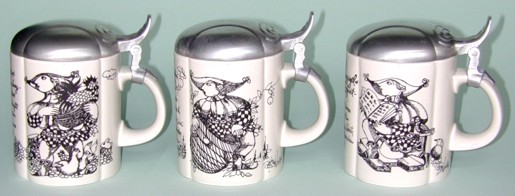 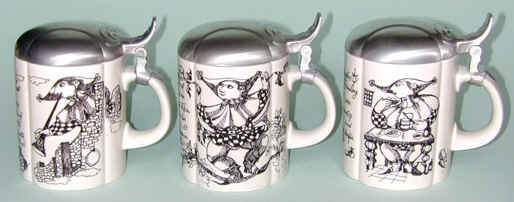 Although this is a set, each stein portrays a different fanciful tale of our hero's adventures in a specific town or locale. From left to right, top to bottom, we see the steins from Quedlinburg, Dorf, Erfurt, Anhalt, Saale and Bamberg. (The complete artwork on these steins may be seen in the separate articles which relate the tales on which they are based.) Three of the steins are signed "Wiinblad 75," two are signed without the date, and one is unsigned, but the artwork is unmistakable. The illustration below provides a view of the lid and the base of these steins, revealing what might be considered a cloverleaf or quatrefoil cross-section whose line is artistically continued from the base through the spun pewter lid. All six pieces were purchased at a shop in Frankfurt, Germany on a single day in 1976-77, on the advice of a Hungarian friend. He insisted that their future value would ZOOM! He may yet be proven right, but currently no one seems to know they exist! 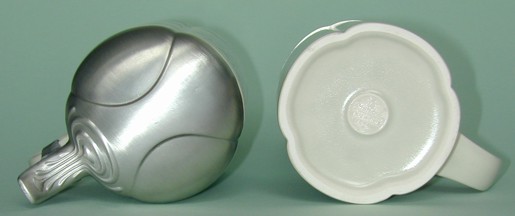 This set is a product of Rosenthal's "studio-linie" from the program "Form ohne Namen," or "form without name." The steins are marked by a raised circular seal in the center of the base. The top half of the seal is the underlined Rosenthal logo. Below that is "studio-linie" and below that the word "GERMANY." Inside the lid there is an impressed stamp with raised letters. Again at the top is the underlined Rosenthal logo, below that the word "GERMANY" and, at the bottom, the signature of Bjorn Wiinblad. If whimsy is your bag, you are in very good company, along with Richard Strauss and Hans Sachs (the Meistersinger). Check out your local library. Five of the tales represented on these steins appear in German in Hausbuch deutcher Sagen und Schwanke collected by Josef Guggenmos. The full narrative of Eulenspiegel's adventures, of which there are 95, was translated to English by Paul Oppenheimer and is available in Till Eulenspiegel, His Adventures. A brief retelling of the two stories which are celebrated on the steins featured in this article provides amusement and helps us to better understand this character. (The number preceding the title of each of these tales identifies its position within the 95 original episodes published in 1515.) Click the links below to read each of the six tales of Eulenspiegel's escapades as depicted on this set of steins.
Till Eulenspiegel, An Enigmatic Character When Col. John Gaustad and I first discussed preparing an article about Till Eulenspiegel, both of us knew him by his common name, "The Merry Prankster," yet neither of us knew much more than that. We embarked upon our research expecting to discover a light-hearted people's hero, a player of practical jokes. The first surprise was to realize that Eulenspiegel was both spectacularly famous and paradoxically unknown. Eulenspiegel is thought by many to be a real person, born in Saxony, who traveled extensively in Germany, as well as Poland, Denmark and Italy, before dying of the Black Plague in 1350 in Mölln. A gravestone in that town commemorates his death. Whether real or legend, Eulenspiegel is a complex figure who played a popular role in socio-cultural expression. He was wildly popular in the Schwank-literatur or "fool's literature" of 16th century, providing a distraction from the burdens of everyday life in the later Middle Ages and the Renaissance. Everyone who could read was ready for a laugh, particularly when it came at someone else's expense. The tales of Eulenspiegel were intended to mock and satirize the pretentiousness of mankind and its institutions, and in them we discover Eulenspiegel in a wide variety of roles - an actor, thief, liar, prankster, devil, saint, sadist, philanthropist and philosopher - and with a special flair for tormenting his victims through the literal interpretation of idiomatic statements or figures of speech. The tales are often vulgar and scatological, both in language and story device. Interestingly, they contain no sexual themes.
The Oppenheimer translation of the original tales
of Tyl Eulenspiegel reveals something quite unexpected to a modem reader. 16th
century humor, reflecting the social and moral climate of the times, seems
harsh, unforgiving, even hurtful. In the 20th century we are amused by a
practical joker who embarrasses and discomfits some person or office, or who
gives his victims an unexpected but temporary shock with his antics. The victims
are sometimes deserving, sometimes simply convenient, but the pranks are
harmless, and their effect is soon gone. But Eulenspiegel was able to victimize
anyone, innocent or deserving, and was always happy to use his pranks to gain
personal benefit. When his artful shrewdness was insufficient, Eulenspiegel
readily resorted to lying. He is a mischief maker bent on deceit. While he does
trick the dishonest, harsh, cruel, stupid, conceited, obnoxious, boring and
pretentious - in short, the deserving - he also preys on the naive, the gullible
and the innocent. His tales are often explained as learned reflections on society,
religion, education and political systems of the day. By satirizing and making
fun of these institutions while taking advantage of their members, his tales
were a popular source of laughter and relief from the uncertainty of everyday
life in the 16th century. |
||||||
